Food Storage Tips You Need
Today I’m sharing my food storage tips you need to make your stash exactly what YOU want. We all have different budgets and spaces to store food for our family. Yes, we have to be creative sometimes. I’ve heard people say “my house is too small” to store anything. As we update this post, we’re going to give you some handy ideas you might not have thought about.
Unless you have a “tiny house” like you see being advertised which is only about 200 square feet, you may have room and you don’t really know it. I used to store #10 cans of wheat in my master bedroom closet. You may not want to do that, but that is why I decluttered my home so I could store the things I need.
Please note, I’m updating this post as I have sold my home in Southern Utah and we are building a small home up north. Stay tuned, I will share how I store everything in this new home half of the size I just left. We’re about 9-12 months out.
My guest bedroom had fifteen 6-gallon buckets of hard white wheat lining one of the walls. I had 56-gallons of water stored under the bed in WaterBricks. My grandkid’s guest room there had Costco racks with #10 cans, it’s too hot there to put anything in the garage, except my preps. As I write this I’m thinking and actually giggling, would my girls have wanted wheat in their bedrooms growing up? If I had a tiny home, I would have a shed with heat and air conditioning.
Let me be clear here, I like a clean, orderly home, it’s very important to me. My guests understand my passion for food storage and emergency preparedness. They just roll with the “stuff” in the guest rooms. My new home will be much smaller, but I’m designing it so it will work.
Food Storage Tips You Need
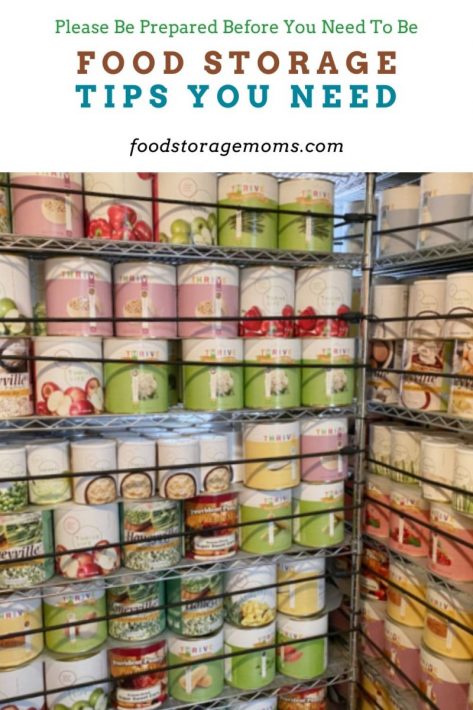
Brands I Recommend
I can only recommend brands I have tried, so here we go. Please compare shipping costs, and per ounce cost before ordering. Just because it’s a #10 can doesn’t mean it’s filled to the top. Volume can vary greatly between companies providing food storage items.
Just get your calculator to find the best deal. Some of these companies only sell “meals,” I realize some of you may prefer just to add water to the packaged meal. I’m not a real fan of the meals approach, but that’s just me. I always want to remind people to be sure and buy only what family members will eat.
I’ll be honest, I can’t recommend buying “some” freeze-dried items today because of the cost. Because food, in general, is a lot more expensive, all packaged food storage companies need to charge more just to cover the higher prices they are having to pay for the raw products. Right now, I am buying very little commercially processed food. I did buy some milk in pantry-size cans last week. I watch the sales and buy only minimal freeze-dried foods right now.
- Thrive Life
- Honeyville Grain
- Mountain House
- Wise Company
- Legacy Food
- Augason Farms
- Be Prepared
- Valley Food Storage
Can I Purchase Food Monthly?
Yes, you can. I stop and start deliveries according to my budget. I go through Jodi Weiss at Thrive Life. I try to buy $100.00 a month because then I get FREE shipping. This works for me and I keep my food stash inventory built up with what I need to prepare meals. This may or may not work for you. Thrive Life Website
Food Storage Tips
A few days ago I wrote about canned food which I believe we need. Let’s talk about freeze-dried food and dehydrated food today. Please keep in mind, if you dehydrate your own food it will have a shorter shelf life than commercially processed cans. When Mark and took classes to get our Master Canning and Preserving Certificates we were taught that home canned and home dehydrated food have a shelf-life of 12, maybe 18 months.
Yes, I grew up eating peaches that were four years old, I’m sure. My point is that the quality of those foods and the level of vitamins and other nutrients are reduced each year the item is stored. Enough said. Let’s get started with Freeze-Dried and Dehydrated food.
Pantry Size versus #10 Cans
The only company that I’m aware of that sells smaller freeze-dried and dehydrated food in pantry size cans AND #10 cans are ThriveLife. Here’s the deal, the pantry size cans are smaller so you don’t have to open a HUGE #10 can. They work very well for smaller families. In fact, I just ordered jalapenos in the pantry size cans because I like certain foods in the smaller containers. I can empty the pantry size can contents right into my quart mason jars.
Remove The Oxygen Absorbers
After you open the pantry-size cans or #10 cans, discard the oxygen absorbers.
How Do I Store The Food After Opening?
You remove the oxygen absorbers and discard them. Store the food in the container it comes in or put it in an airtight container. I use mason jars after opening my freeze-dried and dehydrated food.
Freeze-Dried Food
Let me explain in a nutshell what freeze-dried food is. The first step to freeze-dried food begins with freezing. The second step is the frozen food is placed in a vacuum chamber under low heat. Then the third step starts when the frozen water crystals evaporate directly from ice to vapor which is a process called sublimation.
What’s really nice about freeze-dried food is the fact that it lasts longer, depending on the manufacturer. Please always look at the cans and see the quoted shelf-life. You can eat the food directly out of the can if you want to, and therefore, it uses a lot less fuel, if any, when it comes to meal preparation.
Freeze-dried foods usually have an open shelf-life of 1-2 years. Here again, please look at the #10 can or on the website of the company you decide to purchase from.
Pros:
Lasts 20-25 years, depending on the company where you purchase the food. You can also eat the food directly out of the can. You don’t need to slice, chop, or cut the food into bite-size pieces. It uses less fuel to prepare the food, if any.
Cons:
It is more expensive, but remember you use less fuel.
Dehydrated Food
Okay, most of us buy dehydrated food every day. We purchase cereal, spices, pasta, beans, baking mixes, etc. Dehydrated food is a product where the water has been removed. The water is slowly removed from the food with heat and airflow without actually cooking it.
It’s one of the most affordable, light-weight, and compact ways to purchase food for our storage or everyday cooking. We need to be aware of the dehydrated process, it generally takes longer to cook because it has to be rehydrated. You can’t “snack” on it right out of the can. It’s too hard. These foods are fine for soups, stews, etc.
We need to remember that typically dehydrated food doesn’t last as long as freeze-dried when stored on your shelves. It usually has a shelf life of 5-8 years. They usually have an OPEN shelf life of 6 months to 1 year.
Pros:
Dehydrated food is a lot cheaper. It’s ready to stir into a pot of soup or chili. No need to chop, slice, or cut into pieces.
Cons:
Shorter shelf-life and you can’t eat the food right out of the can. It must be cooked, and therefore uses more fuel to prepare a meal.
Food Storage For Long-Term
I personally don’t buy ready-made meals because I can cook from scratch with all the freeze-dried and dehydrated foods I buy. You don’t need a special cookbook with food storage. ANY cookbook will work, I promise. Please don’t be afraid of those #10 cans. They are food in a preserved state. Just rehydrate them and they are close to fresh. Not exactly, but very close, let’s be real here.
If you have a casserole that needs green beans, you use your #10 can with green beans. Easy peasy. If your recipe calls for grated cheese, grab a #10 can of grated cheese and add tepid or cool water to rehydrate it. Warm water will cook it, I know because I did that ONCE. It was a learning experience.
Dairy
- Instant Milk
- Cheese
- Sour Cream
- Cream Cheese
- Butter
- Eggs
Vegetables
Everything comes washed, chopped, or sliced and ready to use. Look at all these options!!!
- Asparagus
- Broccoli
- Carrots (dehydrated)
- Celery
- Green beans
- Red bell pepper
- Green bell peppers
- Green onions
- Onions
- Potatoes (dehydrated)
- Tomatoes
- Squash (just a note, I do not care for zucchini that is freeze-dried)
- Cauliflower
- Corn
- Kale
- Mushrooms
- Chili Peppers
- Butternut squash
- Peas
- Spinach
Fruits
You may want to try some of this fruit with my Peach Glaze Recipe. All you do is make a glaze with the fruit you love to eat and scoop it over ice cream, or cake. Life is so good when it’s homemade! If you love strawberries, all you do is trade out the peaches for some strawberries, etc. Check out all the fruit choices!!
- Apples
- Bananas
- Cherries
- Peaches
- Pineapple
- Apricots
- Grapes
- Blueberries
- Mango
- Pears
- Strawberries
- Raspberries
- Blackberries
Meat
Please be aware that freeze-dried or dehydrated meat stores differently. You would think meat would have the same shelf-life, it doesn’t. Another thing is the fact that some meat must be consumed within 2 weeks after you open the can. Yikes! If you buy a #10 can you need to be able to eat it within those two weeks, I wouldn’t be able to do that. This is fine if we have a freezer to store the excess, but what if we lose power for extended days, weeks, or longer? Remember to check all meat for shelf-life unopened AND open.
- Hamburger/Ground Beef
- Chicken
- Beef
- Ham
- Sausage
- Pork
- Turkey
- TVP, Textured Vegetable Protein (dehydrated) Chicken, Beef, Ham, and Bacon
Food Storage For Short-Term
I truly believe right now we must stock up on canned goods that our family will eat. In case you missed this printable on how to plan a week’s worth of meals, here it is FSM Meal Planning Schedule
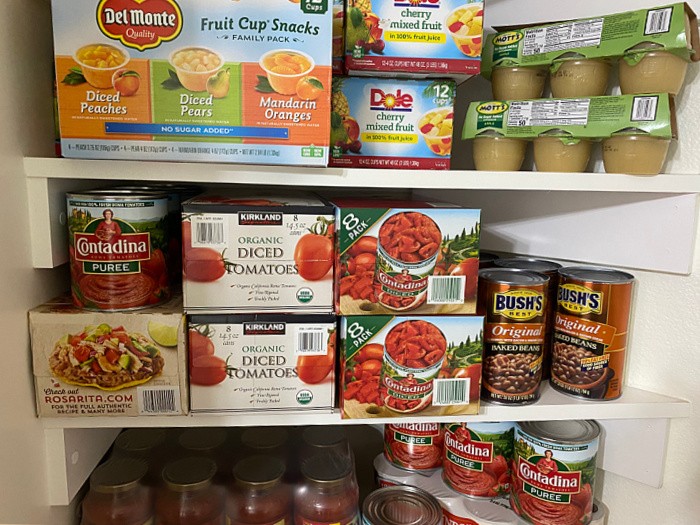
Final Word
Thanks for stopping by today, I hope my food storage tips help you gather the food you need for your family. Don’t be afraid to try different things so you get acquainted with shelf life, flavor, and other traits from each manufacturer. Also, they tend to charge differently for their products, so evaluate if the quality matches the price and make your buying decisions accordingly. Thanks for being prepared for the unexpected. May God bless this world, Linda

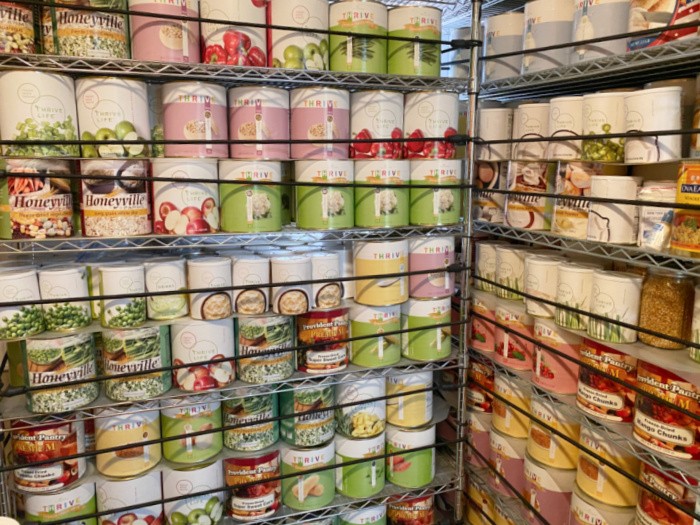



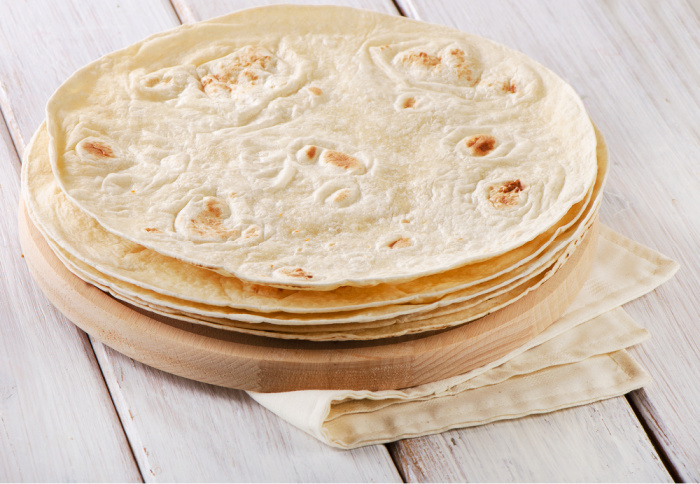

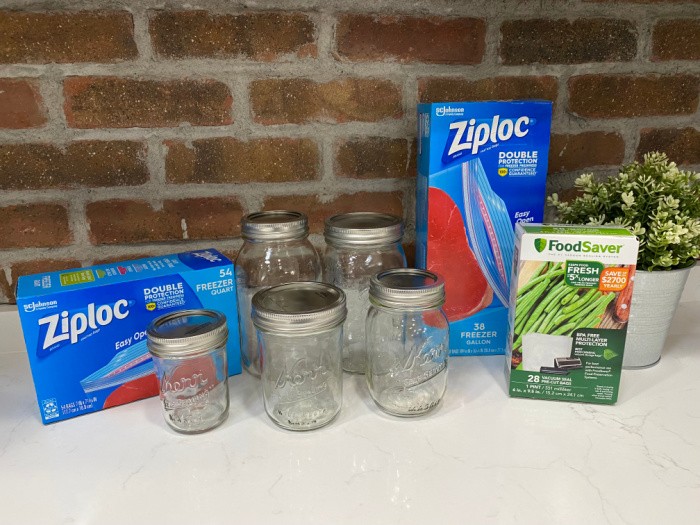
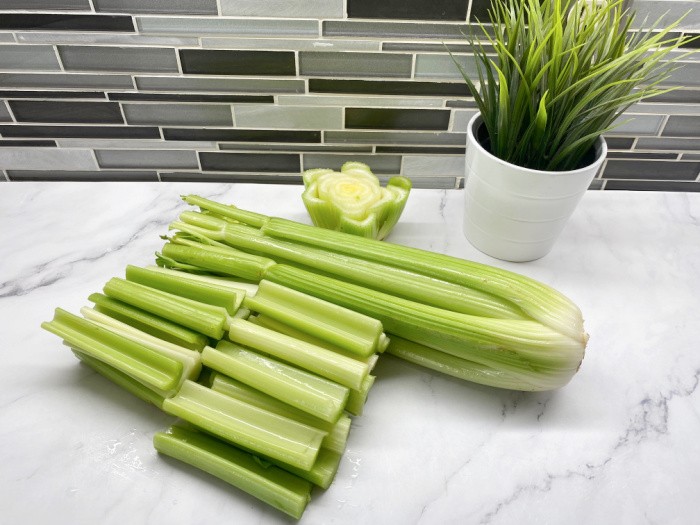














I have a couple of full size closets that I affectionately refer to as the Closet of Life and the Closet of Death
Both are stacked and beauty is on the eye of the beholder. I’m not impressed with shoes
Oh this is great! I’m not impressed with shoes either! Or make-up!
Hi Matt, this is the BEST COMMENT EVER! I have the giggles because I can only imagine the two closets. Closet of Life and Closet of Death! I love it! Linda. Shoes, I only have two pairs. LOL!
Hi Linda. As you know, I live tiny. 192 sq ft. I’ve gotten very creative on my food storage. I used half of my tiny closet for a lot of canned goods, under my bed, around my bed, a tiny stand alone pantry and of course, floor. However, I’m running out of “hiding space”, lol. I believe, one can store anything, but they have to get very creative. I’m thinking I need to back off, a little, on the stuff I’ve been getting, lol. Hey, it’s just me and my dog and thank goodness, he will eat just about anything I do, except blueberries. He hates them. One thing I’m going to try to get this summer is a hand grinder mill, wheat berries and “pop-corn”. I learned yesterday that you can grind pop-corn to get cornmeal. Love my cornbread, lol. I’m thinking I have about 2 to 3 years worth of food for myself and my dog, so will some creative thinking, even tiny home people can prep.
Hi Pam, oh my gosh, I LOVE LOVE LOVE your comment. You live in 192 square feet, I love tiny living. Well, I better say I have never lived tiny before but that is my goal. We are hoping for 1000-1200 square feet so that is not really tiny but it’s tinier than my first home. Yes, make some cornbread with your ground popcorn! Keep in mind any hand-powered wheat grinder takes work, but it’s worth it. We do need to be creative and we are. Linda
zucchini..can be ground for flour and substituted for 1/3 of flour in a recipe…a good extender… ( read this on a post somewhere this week).like zucchini dehydrated, is sweet as is summer squash..
Hi Denise, thanks for the tip! We all love to learn new things, Linda
Rainy Day Foods is another supplier for pantry cans and #10 cans. Anyone else buy from them ?
I have learned so much from Linda and other here. Thank you so much
Mona
Hi Mona, oh my gosh, thank you for the tip! I just looked up the Rainy Day Foods company. They call them #2.5 cans! I love hearing this! Thank you! Linda
Linda,
This is a great article and you covered all the basics really well. I know you aren’t a huge fan of the mylar bag with O2 absorber storage method but I find it works quite well. Just sayin’.
Hi Ray, thank you, my friend. I agree with Mylar bags and O2 absorbers IF you know what you’re doing. And you do. I’ve seen food go bad because the incorrect CC’s of oxygen absorbers were used. Some people think you just drop one in a bag and seal it. Nope, nada. I took two classes on how to use them correctly. It was an eye-opener. Linda
Yeah, I don’t think I’ve ever used less than 3 of the 300cc O2 absorbers in a 5 pound bag of white flour and I usually put in 4. The bags end up looking like they’ve been vacuum sealed. I do the same with any such food stored in mason jars. O2 absorbers are cheap so use more than you think you’ll need.
Hi Ray, the trick is keeping the 02 absorbers “fresh”. People leave them out and they become warm and therefore are useless. They must be quickly put in an airtight container. Some people are not aware of that until down the road their food is rancid. I pray people know how to use them correctly IF they are going to use them. Linda
Linda,
After I open a package of O2 absorbers (which i don’t do until I’m ready to use them immediately) I store the unused absorbers in small mason jars with tight lids.
Hi Ray, I knew you would know how to handle them. It’s other people I worry about. You know exactly what to do! Linda
Whoops just saw a typo. Supposed to be 5 lb bag.
Hi Ray, I fixed it. You’re the best! Linda